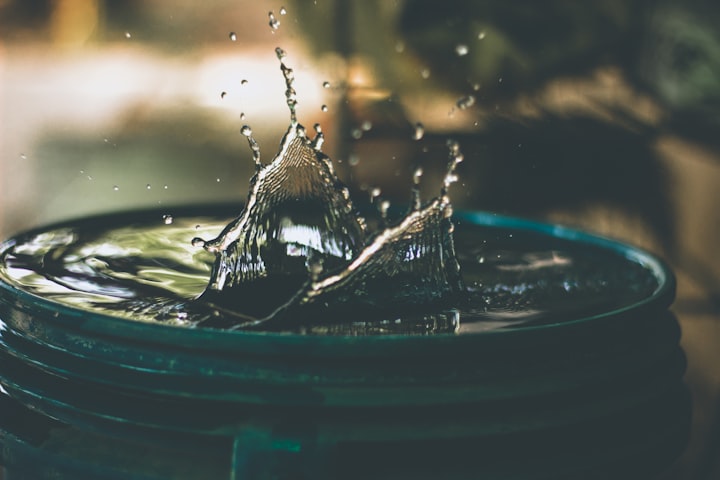
Introduction
Water is an inorganic compound with the chemical formula H2O. It is a transparent, tasteless, odorless, and nearly colorless chemical substance, and it is the main constituent of Earth's hydrosphere and the fluids of all known living organisms (in which it acts as a solvent).It is vital for all known forms of life, despite not providing food, energy or organic micronutrients. Its chemical formula, H2O, indicates that each of its molecules contains one oxygen and two hydrogen atoms, connected by covalent bonds. The hydrogen atoms are attached to the oxygen atom at an angle of 104.45°. "Water" is also the name of the liquid state of H2O at standard temperature and pressure.
Water purification is the process of removing undesirable chemicals, biological contaminants, suspended solids, and gases from water. The goal is to produce water that is fit for specific purposes. Most water is purified and disinfected for human consumption (drinking water), but water purification may also be carried out for a variety of other purposes, including medical, pharmacological, chemical, and industrial applications. The history of water purification includes a wide variety of methods. The methods used include physical processes such as filtration, sedimentation, and distillation; biological processes such as slow sand filters or biologically active carbon; chemical processes such as flocculation and chlorination; and the use of electromagnetic radiation such as ultraviolet light.Water purification can reduce the concentration of particulate matter including suspended particles, parasites, bacteria, algae, viruses, and fungi as well as reduce the concentration of a range of dissolved and particulate matter.A visual inspection cannot determine if water is of appropriate quality. Simple procedures such as boiling or the use of a household activated carbon filter are not sufficient for treating all possible contaminants that may be present in water from an unknown source.
HISTORY OF WATER PURIFICTION
Water purification has a rich history that spans centuries and civilizations. From ancient Egyptian methods of allowing sediment to settle and carefully pouring off clearer water to the practice of boiling water in ancient India, early civilizations recognized the importance of clean water. The 19th century saw advancements with the introduction of filters made of animal charcoal and the discovery of chlorine's disinfecting properties, leading to widespread use in water treatment. Throughout the 20th century, technologies like ultraviolet radiation treatment, reverse osmosis, and ozonation were developed. In recent years, innovative methods utilizing nanotechnology and sustainable materials have emerged. Despite these advancements, ensuring universal access to clean water remains a global challenge, emphasizing the ongoing importance of water purification throughout history.
OBJECTIVES OF WATER PURIFICATON
Water purification can not only help remove harmful containment but also improve the taste, smell and visual appearance of your drinking water. It reduces the amount of chlorine, soil residue, and organic and inorganic substances.
1. Remove contaminants: The primary objective of water purification is to remove various contaminants and impurities from the water, including bacteria, viruses, chemicals, sediments, heavy metals, and organic compounds. This ensures that the water is safe and suitable for drinking, cooking, and other purposes.
2. Prevent waterborne diseases: Water purification aims to eliminate or reduce the presence of pathogens in water, thus preventing the spread of waterborne diseases. By removing harmful microorganisms, such as bacteria, viruses, and parasites, water purification helps protect public health and reduce the incidence of illnesses caused by contaminated water.
3. Improve taste and odor: Water purification processes often address the improvement of taste, odor, and appearance of water. Removing substances that contribute to unpleasant tastes and odors, such as chlorine, sulfur compounds, or algae, helps make the water more palatable and appealing for consumption.
4. Enhance overall water quality: Water purification systems aim to enhance the overall quality of water by reducing the levels of impurities and pollutants. This includes the removal of harmful chemicals, heavy metals, and other contaminants that may have adverse effects on human health or the environment.
5. Ensure water safety and compliance: Water purification plays a crucial role in ensuring that water supplies meet regulatory standards and guidelines for safety and quality. By adhering to established purification processes, water treatment facilities can provide water that meets or exceeds the required standards set by regulatory bodies, ensuring the safety of consumers.
Overall, the objectives of water purification revolve around safeguarding public health, providing clean and safe drinking water, and improving the quality and usability of water resources.
SIGNIFICANCE OF WATER PURIFICATION
Water purification holds immense significance in our daily lives and society as a whole. It plays a critical role in ensuring access to clean and safe drinking water, which is fundamental for human health and well-being. By removing contaminants and impurities from water, purification processes help prevent the spread of waterborne diseases, protecting individuals and communities from illness. Additionally, water purification enhances the taste, odor, and appearance of water, making it more enjoyable to consume. It also ensures compliance with regulatory standards and guidelines, guaranteeing that water supplies meet the required safety and quality standards. Furthermore, water purification is crucial for industries, agriculture, and various commercial applications, as it helps maintain the integrity of processes and products that rely on clean water. From households to hospitals, schools to factories, water purification is essential in maintaining a healthy environment, supporting economic activities, and promoting overall well-being.
About the Creator
Ranju regmi
Never give up.





Comments
There are no comments for this story
Be the first to respond and start the conversation.